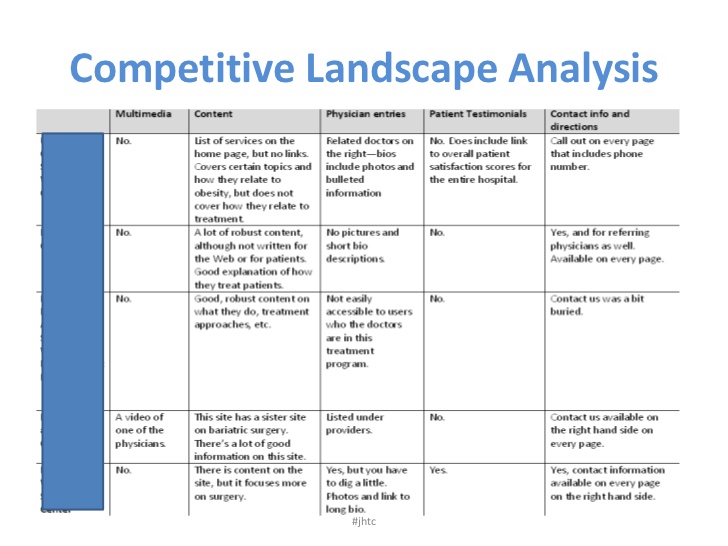
8 steps to creating a competitive landscape analysis
One of the most frustrating business situations is when you’re getting left in the dust by your competition — and you can’t figure out why. Your products are top quality, your customer service is attentive, your marketing is sharp and informative, but you still see your market share slip away. To solve this mystery, you can’t just idly observe your competitors and wonder what they’re doing right. You need to take a methodical approach and create a competitive landscape analysis.
A competitive landscape analysis is a proactive way to understand how you compete with your industry peers. By leveraging your business’s strengths, you can make up the ground between you and your competitors, avoiding a purely reactive approach. It takes planning and effort to do it right, but the benefits can be significant.
What is competitive landscape analysis?
A competitive landscape analysis is a structured way of identifying and researching your competitors. You perform a detailed investigation into how they conduct product development, marketing, sales, and other vital operations. The analysis allows you to develop counter strategies based on accurate and reliable data instead of guessing why you are underperforming.
A competitive landscape analysis should cover five key topics:
- Who your company’s competitors are
- The products and services your competitors offer
- Your competitors’ strengths and weaknesses
- The strategies your competitors are using to achieve their objectives
- The overall market outlook
Every business can benefit from competitive landscape analysis, from the smallest startup challengers to an industry’s reigning titans. Learning what the competition is doing to grow their bottom line is a great way to grow your own.
The value of competitive landscape analysis
A competitive landscape analysis sets the direction for where your business could go in the future. In the short term, it lays out a plan for the needed next steps. By engaging in a methodical survey of your competitors’ activities, you learn more about who your potential customers are and how you can do a better job of reaching them.
Studying the competition also helps you paint a clearer picture of your company’s unique value proposition (UVP). Knowing your UVP allows you to focus on the extraordinary qualities that make your business stand out. These are the things that you do better or differently than the competition.
Successful businesses know the value of competitive landscape analysis. Around 90% of Fortune 500 companies engage in competitive analysis, and 69% of companies that have outsourced their competitive intelligence operations have reported overall positive results. With a solid plan and the right tools, any business can start reaping the rewards of this useful practice. Here’s how to get started.
Recommended for further reading
8 steps to creating a competitive landscape analysis framework
1. Get organized

Competitive landscape analysis example
Reams of raw data won’t yield many insights if it’s not organized or structured. Step one is to create a tool to organize your data. Create a spreadsheet or matrix you can update, sort, and share. Having a way to visualize your data can be extremely helpful, too.
You’ll have lots of varied information and data points to record, but you can list and categorize your known competitors to get started.
2. Identify your competition
Who are your competitors? And how should you categorize them? You can probably answer that first question off the top of your head, but you shouldn’t limit yourself to studying only the most obvious competition.
Begin with a list of ten competitors and sort them into three categories: primary, secondary, and tertiary.
The primary category is for your direct competitors—companies that provide essentially the same product or service as you.
Secondary competitors are similar, but not quite the same. Companies that sell a version of your product with different features, or market to different demographics, would be your secondary competitors.
The tertiary category includes companies that sell something fundamentally different that could be an alternative purchase to what you’re offering.
To take your competitive analysis framework to the next level, you can also include an industry benchmark in your framework to see how both you and your competitors stack up to the industry averages.
3. Analyze their content
Once you’ve identified the players, you can start reviewing and analyzing the content they’re putting out. Look closely at:
- Their advertising
- The imagery they use
- Their website and everything they publish on it (blogs, whitepapers, ebooks, testimonials, newsletters, etc.)
- Multimedia content like videos, webinars, and podcasts
One way to do this is using software tools to find and scrape the content. Don’t be afraid to engage in manual research when necessary. Pretend you’re a customer, embark on the purchasing journey, and see what content your competitors set out for you. See what themes, messaging styles, and branding choices stand out the most.
4. Monitor their social media

One of the best sources of competitor intelligence is social media. Now more than ever, buyers turn to social media for unfiltered information and real talk about their potential purchasing decisions. B2C and B2B businesses alike are rushing to meet that demand with a compelling social media presence, a consistent voice, and tons of content.
Social media is often where you’ll get the strongest feel for a company’s brand persona. It’s an easy place to discover its newest marketing strategies and see how it engages with its audience.
Because social media is such a vast space, social media listening tools can be very handy here. In fact, social listening for competitive analysis can ensure you’re watching the right hashtags, keywords, and relevant conversations that might be happening.
5. Analyze their marketing strategy and offers
Once you’re watching and listening in all the right places, you’ll be able to perceive the bigger picture of your competitors’ marketing strategy.
What you want to know is:
- Where are they focusing their marketing efforts?
- Where are they purchasing ads?
- What incentives are they offering to draw buyers further into their sales funnel?
Look closely at the CTAs in their content. Check out their opt-ins to see where and how they ask prospects to engage for further information. Join their email list to see first-hand how their email marketing is structured and sequenced. Find out what special offers or giveaways they might be promoting. With this information, you can piece together their tactics for lead conversion.
6. Evaluate their offers and pricing
You don’t just analyze your competition so you can copy what they’re doing. Sometimes you see what isn’t working, so you don’t want to copy that. It’s also essential to consider that a good strategy for a competitor may not be suitable for your company. This is especially true when you’re looking at secondary or tertiary competitors.
However, knowing what your competitors are charging for comparable products or services is important when setting your prices. You can’t expect to win the fight for customers if you’re overcharging. Conversely, significantly undercutting competitor prices can suggest lower quality or minimal customer support.
Studying typical promotional offers for the type of goods you sell can also help you learn about customer expectations. This information can help you determine whether it makes sense to offer customer enticements such as free trials, discounts, or subscriptions.
7. Determine their positioning
Companies with a strong marketing and communications strategy know it’s crucial to create a unique position for themselves in the marketplace. They do this by finding ways to differentiate themselves from their competition. When analyzing your competitors, look for the themes and ideas in their messaging that function as differentiators.
For example, imagine three pizza parlors on the same block. One offers the largest slices; one offers the fastest delivery; and the third promises the healthiest ingredients. They’re all in competition, but they position themselves very differently. To find your own unique selling proposition, you have to know how the competition is positioned.
8. Use competitive analysis frameworks: SWOT, the PEST
You don’t have to invent a structure for a competitive landscape analysis process. There are existing, proven frameworks you can use, such as SWOT and PEST.

SWOT stands for Strengths, Weaknesses, Opportunities, and Threats. Strengths and weaknesses reflect the internal characteristics of your business. Opportunities and threats represent outside factors. In competitive landscape analysis, you try to identify your competitors’ SWOT factors to compare them against your own.
PEST is a complementary framework that explores external factors more deeply. It examines Political, economic, Social, and Technological (and sometimes Legal and Environmental) pressures to understand how a business reacts to them. Other frameworks can be explored, but SWOT and PEST provide a necessary foundation.
Competitive landscape analysis for the win
What does completing a competitive landscape analysis mean for your business? You now have an excellent starting point to devise more effective sales and marketing strategies, find new leads, and shape your brand’s perception.
However, a competitive landscape analysis isn’t a one-and-done process. Your competition isn’t static and unchanging, so you can’t lean too long on a single analysis that captures what happened during a particular period.
Technology is changing marketing and other aspects of business incredibly fast. Therefore, it is good practice to revisit the competitive landscape and update your analysis regularly. With the right frameworks and tools in place, you can ensure that you always have an accurate picture of the companies competing for your customers. You’ll have up-to-date knowledge, allowing you to make the right proactive moves that will help you win in your market.


